
|
Franz Schubert (1797 – 1828) would be amazed to learn that he has come to be regarded as a great symphonist – and astounded that he is discussed (and buried) beside his idol Beethoven, the most influential, if not the greatest, symphonist of them all.
![]() Of all the genres in which Schubert excelled, his symphonies (together with his operas) fared the worst during his brief life.
Of all the genres in which Schubert excelled, his symphonies (together with his operas) fared the worst during his brief life.
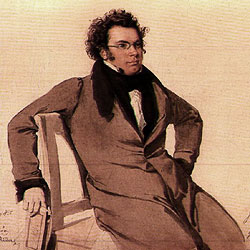 Schubert in 1825 watercolor by Wilhelm August Rieder |
Even so, opinion is rather divided. The most common criticism is Schubert's lack of formal training, which led him toward repetition rather than the genuine development that is the hallmark of the symphony. Thus Adam Carse slights their "tedious, repetitive string parts, indifferently blended winds" and "stiff, conventional brass," although he nonetheless vaunts their warmth and blended color that amply compensates for their lack of texture. Harold Truscott, though, rejects lumping the early symphonies together and hails their orchestration that evolves with each work, finding their nucleus in an unprecedented freedom and variety of the brass. He further denies attempts to characterize the early symphonies as fundamentally classical for the very reason that they root in one harmonic spot, maintain harmonies over long stretches and use non-thematic repetition of short rhythmic motifs (especially dotted ones) to eschew reliance on expansion of the wondrous themes for which Schubert would become known. 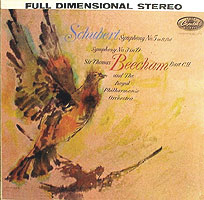 George Grove championed their originality, concluding that, despite the flaws, "there is a fluency and continuity, a happy cheerfulness, an earnestness and want of triviality, and an absence of labour, which proclaim a new composer." Noting that a list of finished works which Schubert prepared in his final year referenced only a single symphony, David Johnson speculates that Schubert would have disowned his early symphonies had he not died too young to master the fate of their posthumous publication.
George Grove championed their originality, concluding that, despite the flaws, "there is a fluency and continuity, a happy cheerfulness, an earnestness and want of triviality, and an absence of labour, which proclaim a new composer." Noting that a list of finished works which Schubert prepared in his final year referenced only a single symphony, David Johnson speculates that Schubert would have disowned his early symphonies had he not died too young to master the fate of their posthumous publication.
Once he left his teens behind, Schubert hit a period of struggle to produce further symphonies. In May 1818 he began two movements for a symphony in D major but abruptly abandoned his preliminary piano scores after a hundred or so measures. In the Spring of 1821 he tried again with four movements (also in D) that never advanced beyond fragmentary piano sketches with a few instrumental indications. Later that year he produced skeletal movements of a symphony in E but orchestrated only the introduction and 76 measures of the first movement. (Mendelssohn declined to complete it, but the work finally became known through an abridgement orchestrated by Felix Weingartner in 1934. Generally light-hearted, it first taunts with a false resolution of an adagio introduction and then intrigues with an allegro suffused with harmonic longing, an andante of an uncommon mood of sustained tranquility, a scherzo that teases with syncopated rhythmic accents wrapped around a heavily-contrasted placid trio, and a finale that dwells more in charm than as the potent culmination typified in the models of the time.) Winter sees all of these abortive experiments as Schubert's attempt to break away from predecessors so as to evolve a more subjective conception of the symphony.
![]() Schubert finally achieved that in November 1822 with his "Unfinished" Symphony that ventures into an entirely new emotional realm and has prompted mystical evocations of its emotional splendor.
Schubert finally achieved that in November 1822 with his "Unfinished" Symphony that ventures into an entirely new emotional realm and has prompted mystical evocations of its emotional splendor. 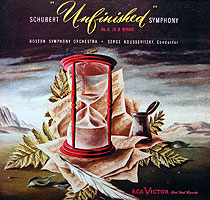 Winter calls the first movement not only unique in Schubert's output but "unprecedented in the symphonic literature … with its towering climaxes, its subjective, almost confessional tone and its extreme contrasts between violence and lyrical pathos." Michael Steinberg agrees that it was "music like no other ever heard before … altogether new in melodic style, the bold mixture of breadth and concision … and the warm glow of orchestral sound." Alfred Einstein asserted that "not even Beethoven had achieved anything more striking or terse than the volcanic climax of the first movement." David Johnson cites its "new and yet uncanny feeling for dark yet phosphorescent instrumentation." Guiseppe Sinopoli regards the work as dwelling in a deeply mystical dream-state of lost, or perhaps wholly imagined, memories. André Maurois felt "the very image of Schubert's soul, always poised to take triumphal flight … but always plunging back into hopelessness." Indeed, while we tend to think of Schubert as bursting with carefree and joyous melody, he revealed a far different side in an 1824 letter to a friend: "I feel myself to be the most unhappy, the most wretched man in the world. … Picture to yourself a man whose brightest hopes have come to naught, to whom love and friendship at best offer only pain … . Each night when I go to sleep I hope never to wake again, and each morning brings me back to yesterday's grief." It is that deeply conflicted Schubert which we hear in the "Unfinished."
Winter calls the first movement not only unique in Schubert's output but "unprecedented in the symphonic literature … with its towering climaxes, its subjective, almost confessional tone and its extreme contrasts between violence and lyrical pathos." Michael Steinberg agrees that it was "music like no other ever heard before … altogether new in melodic style, the bold mixture of breadth and concision … and the warm glow of orchestral sound." Alfred Einstein asserted that "not even Beethoven had achieved anything more striking or terse than the volcanic climax of the first movement." David Johnson cites its "new and yet uncanny feeling for dark yet phosphorescent instrumentation." Guiseppe Sinopoli regards the work as dwelling in a deeply mystical dream-state of lost, or perhaps wholly imagined, memories. André Maurois felt "the very image of Schubert's soul, always poised to take triumphal flight … but always plunging back into hopelessness." Indeed, while we tend to think of Schubert as bursting with carefree and joyous melody, he revealed a far different side in an 1824 letter to a friend: "I feel myself to be the most unhappy, the most wretched man in the world. … Picture to yourself a man whose brightest hopes have come to naught, to whom love and friendship at best offer only pain … . Each night when I go to sleep I hope never to wake again, and each morning brings me back to yesterday's grief." It is that deeply conflicted Schubert which we hear in the "Unfinished."
Schubert himself never heard it. Nor would anyone else for over 40 years. As a gesture of gratitude he sent the score to Anselm Hüttenbrenner, who had recommended him for membership in a music society but, perhaps out of jealousy, never bothered to deliver it and kept it for himself. He only released it when Johann Herbeck promised to include one of Hüttenbrenner's own inferior works in a December 1865 concert. 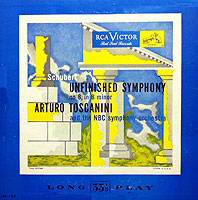 It soon became the most popular of all Schubert's works. Known as the "Unfinished," the symphony consists of only two movements. But why?
It soon became the most popular of all Schubert's works. Known as the "Unfinished," the symphony consists of only two movements. But why?
Speculation abounds. Some consider the torso as an entirely satisfying unified entity. Thus Anthony Burton saw the first movement as a "perfect juxtaposition of dramatic tension and lyrical ease" and the second "full of restless wandering and turmoil, coming to rest in other-worldly serenity," while William Mann perceived "the storm and stress of life contrasted with the serenity of eternal bliss in which violence and turbulence are but distant memories." Yet such views are often dismissed as a Romantic indulgence and a mere rationalization of having no choice but to accept the portion we have (and, indeed, the two movements hardly seem complementary, not only in mood but dwelling in the unrelated keys of B Minor and E Major). Some believe that Schubert may have reworked the remainder into other pieces, or that he changed course to suppress the painful memory of the syphilis he had just contracted and that surely darkened his psyche, or that he could not find a suitable completion for these two slow, intensely dramatic movements. Indeed, Schubert did sketch a scherzo and trio, but orchestrated only the first nine bars. Louise Cuyler considers the result commonplace and "certainly not of a caliber to enhance the two completed movements," while Donald Francis Tovey hails its theme as "magnificent and the sketches for it very promising." Its theme indeed is enormously catchy and, as completed by others, its mood a buoyant, wrenching shift from the rest. But that alone hardly disqualifies it as appropriate to the two completed movements – Beethoven, for one, brightened the funereal humor of his “Eroica” and Seventh Symphonies with jaunty scherzos that served as transitions to momentous finales.
|
The Unfinished Symphony scherzo theme in manuscript and print |
Some claim that Schubert probably did finish the work but, typical of his haphazard ways, lost the rest. But perhaps the most likely explanation, albeit the most prosaic, is that he simply lost interest. Had Schubert lived to a ripe old age when his phenomenal inspiration began to flag, he might have gone back to develop ideas and fragments of the past, but for now he was so full of music that new works kept pouring out as fast as he could write them down. Indeed, friends recalled how Schubert would read a poem he liked, rush off to his room, and emerge with a masterful song in final form. Consistent with his fertile and prolific genius he rarely revisited or reworked material; rather, he just moved forward and wrote a new piece. And so, perhaps, here – rather than wrestle with the challenge of completing the "Unfinished" he let inspiration carry him elsewhere.
![]() L. Michael Griffel asserts that Schubert was in such awe of Beethoven that he was hesitant to publish a symphony that would be found lacking when invariably compared to those of the Master. Yet in 1824 he wrote of his plan to create a grand symphony and in October 1826 sent a complete symphony in C Major to the Austrian Musical Society with a fawning but hopeful note expressing that he was convinced of their "noble intention to support my artistic endeavor as far as possible. I venture, as a native artist, to dedicate to them this, my Symphony, and to commend it most politely to their protection." (Schubert's boast of his provenance was true – he was the only major Viennese composer actually born there.) Apparently the Society at first was sufficiently impressed to remit 100 florins (albeit rather insultingly "as a token of the Society's sense of obligation to you") and to prepare orchestral parts, but after a single rehearsal "provisionally" set it aside "due to its length and difficulty," never scheduled it for performance and ultimately returned it. John Reed suspects that the rejection largely reflected the undemanding standards of public taste to which the Society had to cater.
L. Michael Griffel asserts that Schubert was in such awe of Beethoven that he was hesitant to publish a symphony that would be found lacking when invariably compared to those of the Master. Yet in 1824 he wrote of his plan to create a grand symphony and in October 1826 sent a complete symphony in C Major to the Austrian Musical Society with a fawning but hopeful note expressing that he was convinced of their "noble intention to support my artistic endeavor as far as possible. I venture, as a native artist, to dedicate to them this, my Symphony, and to commend it most politely to their protection." (Schubert's boast of his provenance was true – he was the only major Viennese composer actually born there.) Apparently the Society at first was sufficiently impressed to remit 100 florins (albeit rather insultingly "as a token of the Society's sense of obligation to you") and to prepare orchestral parts, but after a single rehearsal "provisionally" set it aside "due to its length and difficulty," never scheduled it for performance and ultimately returned it. John Reed suspects that the rejection largely reflected the undemanding standards of public taste to which the Society had to cater.
The top of the score appears to bear a date of Marz (March) 1828 above Schubert's signature, which has caused considerable confusion.
 The signature and "date" |
Further confusion has arisen surrounding the so-called "Gastein Symphony." Schubert was known to have written a symphony in Gastein, where he spent most of May through October 1825, but no trace of it has ever surfaced. For a while, scholars considered it to be his Grand Duo, D.812, for piano four hands, due in part to its density and overall orchestral character.
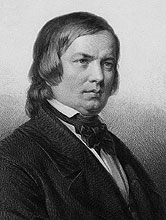
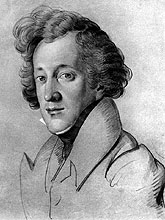 Schumann and Mendelssohn |
Schubert never heard his "Great" symphony. (Nor did its premiere materialize in December 1828, a month after his death, when it was considered for a memorial concert but rejected, this time in favor of his juvenile but more readily appealing Symphony # 6.) Like the "Unfinished," the "Great" emerged long after Schubert's demise. His brother Ferdinand, with whom he had lived in his final months, sold many of Schubert's manuscripts to publishers and thus fueled a posthumous reputation that had eluded Schubert during his short, impoverished and largely unnoticed life. Robert Schumann, remembered nowadays as a composer but better known in his time as an influential music critic, visited Ferdinand in 1839 to examine the remaining scores and was amazed to discover an extraordinary complete symphony in C major. Schumann brought it to the attention of his friend Felix Mendelssohn, also now famed for his compositions but celebrated then as the conductor of the finest orchestra in Europe, the Leipzig Gewandhaus. Fired with enthusiasm, Mendelssohn proclaimed it to be remarkable, "bright, fascinating and original throughout" and "without doubt one of the best works which we have lately heard," gave the world premiere (albeit cut to omit all the repeats), and tried to champion further performances, but was thwarted by resistance from the musicians who protested the length and complexity of the work and openly scorned it, with the violinists especially objecting to the exhausting repeated rapid ostinato figures in the finale. That defiance persisted for quite some time – Mendelssohn's attempts to program the work in London and Paris were foiled altogether, the Vienna Philharmonic would play only the first two movements (and even then inserted a Donizetti aria between them), and for the first English performance – only in 1856 – the four movements were split between two concerts held a week apart.
![]() Critical opinion, too, initially failed to ignite. The most prevalent censure of the "Great" disparaged its length, repetition, structure and development. In reviewing an 1859 concert, the Manchester Guardian found "little coherence" and "scarcely a trace of the consistency of design which is one of the great charms in the symphonies of Haydn, Mozart, Beethoven and Mendelssohn." Grove, too, found it diffuse: "When a passage pleases [Schubert] he generally repeats it at once, almost note for note. He will reiterate a passage over and over in different keys, as if he could never have done." In their 1939 Men of Music, Wallace Brockway and Herbert Weinstock assert that it has "a beginning as promising as any symphony ever had" but then "lapses into a vein of irrelevant garrulousness" and "concludes on a maundering, inconsequential note." It has been suggested that had Schubert not always been in such haste to pump out more music he would have taken the time to edit his work and pare its rambling.
Critical opinion, too, initially failed to ignite. The most prevalent censure of the "Great" disparaged its length, repetition, structure and development. In reviewing an 1859 concert, the Manchester Guardian found "little coherence" and "scarcely a trace of the consistency of design which is one of the great charms in the symphonies of Haydn, Mozart, Beethoven and Mendelssohn." Grove, too, found it diffuse: "When a passage pleases [Schubert] he generally repeats it at once, almost note for note. He will reiterate a passage over and over in different keys, as if he could never have done." In their 1939 Men of Music, Wallace Brockway and Herbert Weinstock assert that it has "a beginning as promising as any symphony ever had" but then "lapses into a vein of irrelevant garrulousness" and "concludes on a maundering, inconsequential note." It has been suggested that had Schubert not always been in such haste to pump out more music he would have taken the time to edit his work and pare its rambling.
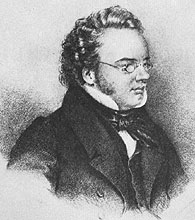 Schubert in 1826 Lithograph by Josef Teltscher |
Once the "Great" became better known praise became far more prevalent. To Einstein, through this single gesture Schubert declared himself to be Beethoven's peer. To Griffin, Schubert had matched Beethoven's symphonies while managing to inject "his special brand of expansiveness, leisureliness, lyricism, instrumental color and harmonic finesse." To Winter, Schubert found his symphonic voice through "unquenchable rhythmic vitality." Carse salutes the color, blend and warmth of Schubert's full-bodied instrumental textures, and especially the wealth of brass tone that is featured throughout rather than to just to bolster tuttis. Mann relates the spacious design to the unhurried regal majesty of the tunes and cites as a particular example the trio, which languishes for 47 bars to reach the end of its first sentence. He also rebuts the commonplace notion that Schubert was "just a naïve genius, all tunes and no brains" by citing the evolution of the finale, in which the four repeated notes of the second subject begin as a "jaunty melody" and wind up being "thundered out as though Judgment Day were at hand." Mann hails the "Great" as a unique synthesis of the lyric and the heroic.
But perhaps the most ecstatic praise was the very first – a remarkably discerning essay by Schumann, inspired by Mendelssohn's premiere performance: "Here we have, besides masterly power over the musical technicalities of composition, life in all its phases, color in exquisite gradations, the minutest accuracy and fitness of expression" that he likened to a thick romantic novel that for the very best reasons can never end.
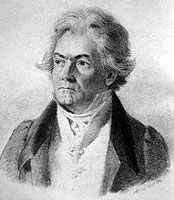 Beethoven in 1824 Drawing by Stephan Decker |
One intriguing theme of historical commentary has been a comparison of Schubert with his idol Beethoven, in whose shadow he dwelled. Beethoven is known to have admired Schubert's songs but the two never met (other than, in a way, at Beethoven's funeral, which Schubert attended) although in 1822 Schubert dedicated a set of variations on a French song to him and tried to deliver a copy but Beethoven was not at home and Schubert never returned. In a sense, such assessments are fundamentally unfair, since Schubert's entire lifetime aligned only with Beethoven's early period and so we have no idea of how his maturity would have compared with the phase of Beethoven's true greatness. Even so, David Hall views the "Great" as extending Beethoven's 1812 Seventh Symphony on a more grandiose scale, as both begin with slow introductions and are dominated throughout by persistent rhythmic figures exploited to the utmost. Lang compares the "Great" to Beethoven's 1824 Ninth (“Choral”) Symphony, which Schubert might have heard one year earlier and declares that Schubert "dared to follow the Titan to dizzying heights, returning unscathed with a work every tone of which is his own and which can be placed next to Beethoven without paling." Their outlooks and temperaments were far from akin – Beethoven tended to be irascible, heroic and tragic while Schubert was essentially passive, tender and mellow. Griffin sums the difference up well: Schubert matched Beethoven's symphonies in length, drive, weight and freshness of form while managing to inject his special brand of expansiveness, leisureliness, lyricism, instrumental color and harmonic finesse. Roger Norrington expands that thought: while Beethoven's Ninth had shocked with its overt drama, "Schubert would show a different way forward. Music would not need to be violent, almost ugly, to say new things. … Development sections, for instance, would not have to argue, they could tell stories. As Beethoven had dramatized Classical form, Schubert would lyricise it."
![]()
I – Andante; allegro ma non troppo – Slow introductions were a staple of the classical symphony, a convention which Schubert observed in all his early ones but the Fifth. Yet his use of the device to open the "Great" was novel in its extraordinary degree of integration with all that follows,
|
The opening, allegro and second themes of the first movement: |
II – Andante – The second movement has been likened to an extended song, the genre of which Schubert was the supreme master. Lang calls it "a most complicated composite utilizing a plethora of material with an assuredness that makes it appear as simple as a song" while Lang cites "imagination and poetry which he never more ardently expressed" and Cross deems it "so strikingly beautiful as to be almost painful."
|
The theme of the Andante: |
III – Scherzo [and Trio]; Allegro vivace – Few commentators have much to say about the third movement,
The gruff and lyrical themes of the Scherzo: |
IV – Allegro vivace – Tovey recounts that among Schubert's rare sketches, for the finale "he dashed off a schoolmasterly little fugue" which he promptly abandoned. As with Beethoven's Seventh, the only effective way to top off the prior rhythmically-infused movements is with not a sobering plunge into a dry academic exercise but a whirl of unquenchable energy that at the same time manages to serve as a natural culmination of the moods and structures of its predecessors.
The fanfare and emphatic themes of the Finale: |
A brief word about numbering – it's confusing! 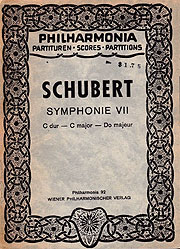 Although most often identified nowadays as Schubert's Symphony # 9, the "Great" at various times has also been counted as # 7 (when first discovered, as only the six juvenile symphonies then were known), # 8 (once the "Unfinished" surfaced), # 9 (when number 7 was reserved in expectation that the "lost" Gastein symphony would be found) and, rarely, # 10 (when the nearly-complete 1821 E Major symphony is included). Older scores and recordings can be somewhat misleading by reflecting the earlier labels, so a more reliable guide is the "D" numbering in the chronological catalog of Schubert's works compiled by Otto Deutsch in 1951, in which the "Great" is assigned D 944 (although that late number mistakenly assumed that it was written in Schubert's final year rather than in 1825, as subsequent scholarship determined, which would have warranted a Deutsch number in the mid-800s). Similar confusion attaches to the "Unfinished," which is variously cited as # 7 (in order of composition) or, most commonly, as # 8 (in order of posthumous publication), and in any event is reliably identified as D 759.
Although most often identified nowadays as Schubert's Symphony # 9, the "Great" at various times has also been counted as # 7 (when first discovered, as only the six juvenile symphonies then were known), # 8 (once the "Unfinished" surfaced), # 9 (when number 7 was reserved in expectation that the "lost" Gastein symphony would be found) and, rarely, # 10 (when the nearly-complete 1821 E Major symphony is included). Older scores and recordings can be somewhat misleading by reflecting the earlier labels, so a more reliable guide is the "D" numbering in the chronological catalog of Schubert's works compiled by Otto Deutsch in 1951, in which the "Great" is assigned D 944 (although that late number mistakenly assumed that it was written in Schubert's final year rather than in 1825, as subsequent scholarship determined, which would have warranted a Deutsch number in the mid-800s). Similar confusion attaches to the "Unfinished," which is variously cited as # 7 (in order of composition) or, most commonly, as # 8 (in order of posthumous publication), and in any event is reliably identified as D 759.
![]() We can only speculate as to the wondrous masterworks Schubert would have crafted had he been allotted a reasonable longevity. It's astounding how many inspired works he produced in so many diverse genres in the course of his cruelly-abbreviated time. Indeed, with the possible exception of Mozart, any other of the great composers, had they lived so briefly, would barely be remembered, and then only as an unfulfilled promise. Consider Beethoven. Had he died in 1801 at Schubert's tender age of 31 he would have written no "Eroica," Fifth, Pastoral, Seventh or "Choral" symphonies, no "Appassionata" or "Hammerklavier" piano sonatas, no "Archduke" trio, no "Kreutzer" violin sonata, no Violin Concerto, no "Emperor" piano concerto, no middle or late quartets, no Fidelio opera, no Missa Solemnis – in short, none of the inspired works that revolutionized and changed the course of Western music and on which his fame is based. Significantly, the inscription on Schubert's tombstone, penned by Franz Grillparzer, reads: "Die Tonkunst begrub hier einen reichen Besitz, aber hoch viel schönere Hoffnungen" ("The art of music here entombed a rich possession, but even far fairer hopes").
We can only speculate as to the wondrous masterworks Schubert would have crafted had he been allotted a reasonable longevity. It's astounding how many inspired works he produced in so many diverse genres in the course of his cruelly-abbreviated time. Indeed, with the possible exception of Mozart, any other of the great composers, had they lived so briefly, would barely be remembered, and then only as an unfulfilled promise. Consider Beethoven. Had he died in 1801 at Schubert's tender age of 31 he would have written no "Eroica," Fifth, Pastoral, Seventh or "Choral" symphonies, no "Appassionata" or "Hammerklavier" piano sonatas, no "Archduke" trio, no "Kreutzer" violin sonata, no Violin Concerto, no "Emperor" piano concerto, no middle or late quartets, no Fidelio opera, no Missa Solemnis – in short, none of the inspired works that revolutionized and changed the course of Western music and on which his fame is based. Significantly, the inscription on Schubert's tombstone, penned by Franz Grillparzer, reads: "Die Tonkunst begrub hier einen reichen Besitz, aber hoch viel schönere Hoffnungen" ("The art of music here entombed a rich possession, but even far fairer hopes").
What would Schubert's impact have been had he lived?
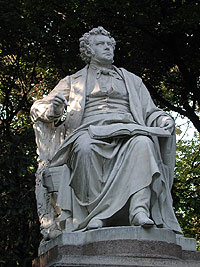 Statue in the state park, Vienna |
That, in turn, invokes a corollary debate over Schubert's symphonic style. While shrinking from George Bernard Shaw's harsh evaluation ("the lamentable truth [is] that a more exasperatingly brainless composition was never put on paper") few would deny that the "Great" has its challenges, if not flaws, including its repetition, weak counterpoint, constant pressing of structural bounds – and sheer length. Indeed, as Northcutt points out, the "Great" was the longest purely orchestral symphony for nearly a half-century, until Bruckner's Second. Steinberg cites a joke that of Schubert's two mature symphonies, one is unfinished and the other endless. (Yet when asked if Schubert's prolixity put him to sleep, Igor Stravinsky, who championed concision, replied: "What does it matter if, when I awake, it seems to me that I am in paradise?") Indeed, it seems entirely suitable to hail Schubert's leisurely style as opening a door to a future that would prize sustained mood, patient development and a hypnotic focus, an esthetic that paved the way toward Bruckner, Wagner, Mahler, Debussy, Messiaen and even electronic and trance music. Yet, as Maurice Brown pointed out in the 1954 Grove's Dictionary, Schubert had little direct influence, as his far-reaching achievements became known only after music had already moved beyond them on its own.
Viewed another way, Beethoven wrote increasingly "impractical" music because he became deaf and thus had to dwell in a world of abstract sound. Schubert did so because, as Harold Schonberg points out, he was the first great composer not to have been a performer and thus was removed from the needs of audiences and patrons (with whom he was too shy to associate anyway). Indeed, in Schubert's lifetime few of his works were commissioned or published and only a single public concert of his works was held. Rather, his only audience was his circle of friends, for whom he wrote songs and chamber works. As a result, Cross accords Schubert the luxury of writing for his own delight and according to his own conscience, investing his work with the radiant joy of creation in which everything flowed naturally and without obstruction. Thus Schubert can be hailed as the first of that rare breed of great composers who had the freedom to follow their own muse.
![]() Yet while we can only wonder about the masterful songs, operas, sonatas, trios and quartets that might have been, we do have a tantalizing clue of what might have lain ahead in the realm of the symphony.
Yet while we can only wonder about the masterful songs, operas, sonatas, trios and quartets that might have been, we do have a tantalizing clue of what might have lain ahead in the realm of the symphony.  Schubert devoted the last month of his life to a symphony in D major, even though he left only fragmentary piano sketches when he died. At first collected in a folio of nine incomplete movements in D major, analysis of the papers in 1978 established a chronology placing three in late 1828 (and the others in 1818 and 1820-1). Brian Newbould, who produced a somewhat speculative performing version based on "painstaking interpretation" of "decipherment … fraught with problems," readily admits: "There can be little doubt that, if Schubert had lived to continue work on this symphony he would have revised it as he went; we cannot visualize what its final shape might actually have been," and, indeed the 27 minutes of the Newbould realization seem somewhat slight. Perhaps with that in mind, and disdaining musicologists who "pretend they are Schubert" and through "philological bureaucracy" wind up irreparably damaging the integrity of the originals, Luciano Berio fashioned a more fanciful illumination in his 1989 Rendering, filling the gaps in Schubert's sketches with "delicate musical cement that comments on the discontinuities and the gaps between one sketch and the other [that] is always announced by the sound of a celesta, … a kind of connective tissue constantly different and changing, always pianissimo and 'distant,' yet intermingled with reminiscences of the late Schubert (the Piano Sonata in B flat, the Piano Trio in B flat, etc.) and crossed by polyphonic textures based on fragments of the same sketches."
Schubert devoted the last month of his life to a symphony in D major, even though he left only fragmentary piano sketches when he died. At first collected in a folio of nine incomplete movements in D major, analysis of the papers in 1978 established a chronology placing three in late 1828 (and the others in 1818 and 1820-1). Brian Newbould, who produced a somewhat speculative performing version based on "painstaking interpretation" of "decipherment … fraught with problems," readily admits: "There can be little doubt that, if Schubert had lived to continue work on this symphony he would have revised it as he went; we cannot visualize what its final shape might actually have been," and, indeed the 27 minutes of the Newbould realization seem somewhat slight. Perhaps with that in mind, and disdaining musicologists who "pretend they are Schubert" and through "philological bureaucracy" wind up irreparably damaging the integrity of the originals, Luciano Berio fashioned a more fanciful illumination in his 1989 Rendering, filling the gaps in Schubert's sketches with "delicate musical cement that comments on the discontinuities and the gaps between one sketch and the other [that] is always announced by the sound of a celesta, … a kind of connective tissue constantly different and changing, always pianissimo and 'distant,' yet intermingled with reminiscences of the late Schubert (the Piano Sonata in B flat, the Piano Trio in B flat, etc.) and crossed by polyphonic textures based on fragments of the same sketches."  While nowhere near as radical a transformation as Berio's most famous work – his 1968 Sinfonia, which adds a wide range of vocal and instrumental overlays to a disjointed scherzo from Mahler's “Resurrection” Symphony, – the result is both beguiling in its own right and firmly in the spirit of its inspiration, a springboard into the far future whose ultimate destination perhaps even Schubert never fully conceived. Indeed, given the phenomenal esthetic journey he had already packed into the last decade of his short life we can only ponder what Schubert might have achieved had he been allotted even a few more years, much less the 30 or so to which he should have been entitled.
While nowhere near as radical a transformation as Berio's most famous work – his 1968 Sinfonia, which adds a wide range of vocal and instrumental overlays to a disjointed scherzo from Mahler's “Resurrection” Symphony, – the result is both beguiling in its own right and firmly in the spirit of its inspiration, a springboard into the far future whose ultimate destination perhaps even Schubert never fully conceived. Indeed, given the phenomenal esthetic journey he had already packed into the last decade of his short life we can only ponder what Schubert might have achieved had he been allotted even a few more years, much less the 30 or so to which he should have been entitled.
Newbould characterizes the first movement as apparently intended to be a sonata-form on a grand scale, with "a lyrical second subject in the cellos that is pure Schubert," and the second movement as both poetic and desolate, prophesying Mahler in its textures and atmosphere. Yet the most remarkable movement (at least as heard in the Newbould restoration) is the third, a combined scherzo and finale that presents a texture unprecedented in the entire prior Schubert canon – as noted by Newbould a "tour de force of counterpoint" including canon, augmentation and fugato and concluding with a combination of the two principal themes. (Painfully aware of the major gap in his musical training, Schubert resolved to embark on counterpart lessons, of which he lived to attend only the first, and indeed the leaves on which he wrote out the symphony sketches are interwoven with his counterpoint exercises.) Would contrapuntal explorations have infused an entirely new path for Schubert, much as it impelled Beethoven's final decade? Viewing the work as a whole, Griffin hails it as the fountainhead of the full-blooded Romantic symphony, with Lisztian transformations of theme, Brahmsian syntheses of gypsy tunes and contrapuntal erudition, and Brucknerian pace, glowing brass textures and buildup of sound. But how Schubert would have topped his "Great" must remain forever unknown.
![]() Schumann concluded his essay on the "Great" on a poignant note.
Schumann concluded his essay on the "Great" on a poignant note. 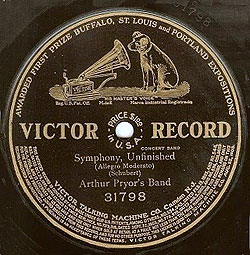 He cited the universal praise by both artists and amateurs in that first audience, predicted that the "Great" would never be forgotten or overlooked, and yet regretted that he was unable to convey that message to Schubert. While we are powerless to remedy his regret, his prediction is affirmed through a plethora of recordings.
He cited the universal praise by both artists and amateurs in that first audience, predicted that the "Great" would never be forgotten or overlooked, and yet regretted that he was unable to convey that message to Schubert. While we are powerless to remedy his regret, his prediction is affirmed through a plethora of recordings.
Schubert undoubtedly would be incredulous to learn that each of his juvenile symphonies not only survived the single performance for which they were intended, but are preserved, revered and enjoyed through dozens of recordings by prominent conductors and ensembles. Their modern recognition was fueled in large part by the advocacy of Sir Thomas Beecham, whose recordings delightfully combine relaxed geniality and elegant grace, and then expanded by original instrument and chamber ensembles whose reduced forces seem ideally suited to their modest scale. While the first six had to await the electrical era for their phonographic debuts, the "Unfinished," Schubert's most popular work, not surprisingly emerged early in the acoustical era. Competing abridgements of the "Unfinished" appeared barely a year after the first recording of a complete symphony (Beethoven's Fifth by the Odeon Symphony Orchestra, in 1911 [or 1910] by Friedrich Kark [or possibly Eduard Kuenneke – the scholarship is confusing]) – a remarkably crisp and propulsive reading by Prince's Symphony Orchestra on a double-sided Columbia disc, and a more mellow rendition of just the first movement by Arthur Pryor's Band on a single Victor side. A half-dozen complete acoustical recordings followed, culminating with an exquisitely lush set by Leopold Stokowski and the Philadelphia Orchestra (Victor, 1924) – what a shame they never recorded the "Great" – all of which were superseded by a dozen more in the first decade of the electrical era.
Although the phonographic appeal of the "Unfinished" may have been abetted by its ability to fit comfortably on a mere three double-sided 78s (and later a single LP side), the "Great" understandably was a harder sell. The acoustical era saw only the Andante, on four sides and thus presumably complete, from Dirk Foch and the Vienna Philharmonic (Grammophon, 1924).
Recordings of the "Great" confront several problems stemming from its sheer length and hallmark repetition. The first is a matter of suitable pacing. David Montgomery reminds us that the Viennese style consists of leisurely tempos and humorous grace that derive from dance traditions – and Schubert was the most Viennese of all the great musicians associated with that cultural center (Mozart, Beethoven), as he was the only one born and raised there. (Indeed, Schumann asserted in his review: "On hearing Schubert's symphony and its bright, flowery, romantic life, the city [of Vienna] crystallizes before me, and I realize how such works could be born in these very surroundings.") 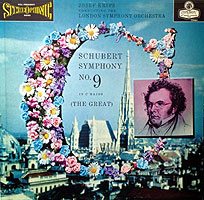
 Yet in our age of constant activity, impatience and instant gratification the "Great" can overstay its welcome, prompting many interpreters to add structural definition and variety through inflection and tempo shifts.
Yet in our age of constant activity, impatience and instant gratification the "Great" can overstay its welcome, prompting many interpreters to add structural definition and variety through inflection and tempo shifts.
That, in turn, invokes the fundamental consideration of whether to view the "Great" as essentially classical or Romantic in feeling (a dichotomy often reflected in LP album covers). On the one hand, the sheer regularity of a straightforward classical approach tends to accentuate its length and can lead to tedium. Yet most critics tend to reject a more subjective slant as bypassing the composer's mild personality in order to indulge the excesses of interpretive ego. Thus Mortimer Frank, writing approvingly of Toscanini's relative objectivity, trashed the proactive Harty, Walter, Furtwängler and Mengelberg recordings as "rather incoherent, consisting of a series of disconnected (though very expressive) episodes rather than a unified whole." Similarly, a 1955 Record Guide faulted Krips for the "vulgarism" of "committing the fashionable error of broadening the tempo in the coda of the first movement." While vaunted for his literalism, even Toscanini didn't escape censure for insufficient detachment – Spike Hughes' analysis of the 1947 Toscanini NBC recording faulted its lack of rhythmic precision as "striking at the very root of rhythm," his hurrying through dotted-note sequences as subjecting the music to "an unnatural stimulation which deprived them of most of their effectiveness" and his speeding up portions of the finale as spoiling the emotional intensity and natural impulse and depriving Schubert from speaking for himself. Perhaps all that can be said with any assurance is that successful presentation of the "Great" admits a broad range of interpretation from strict discipline to bounding freedom.
A related question is whether to take repeats, and, if so, which ones. In keeping with classical tradition, the score indicates that not only the first-movement exposition (about 3 minutes) and both halves of the scherzo and trio (about 5 minutes) are to be repeated, but also, less commonly, the entire first third of the finale (about 4 minutes). Repeats served an important function back in Schubert's time when concerts were rare and audiences would benefit from the familiarity of hearing the basic elements again. (But not always – Antonin Dvorak, writing in 1893, opined that as a general rule symphonies are made too long and "thoroughly approved" omitting all repeats "which, indeed, is now generally accepted" [although, curiously, he included a repeat of the entire first movement exposition in his “New World” Symphony that very same year].) Nowadays recordings afford us the luxury of listening as often as we like, thus obviating the need for repeats.
 Schubert's cryptic notation |
A more granular issue is the meaning of Schubert's cryptic notation. Consider the final sustained note over which Schubert wrote an oblique sign in the autograph – did he intend a long diminuendo that slowly fades the rhythmic vigor into an infinite distance (like the end of Dvorak's “New World” Symphony) or a sustained note begun with an accent to add a final zing to a movement of perpetual energy? (The published score – which, of course, Schubert never saw – tries to have it both ways by marking the final note with a "fz" (forzando = quick, forceful accent) followed by a diminuendo.) Or consider the opening – most conductors play it quite slowly and then accelerate for the ensuing allegro exposition, although Truscott, for one, considers this to signal ignorance of the continuity of Schubert's thoughts. Significantly, the published score specifies an alla breve time signature (two beats to a bar) so as to suggest that a brisk initial tempo is to glide effortlessly into the body. Indeed, in his famous essay Schumann remarked that "the tempo does not vary" and marveled at how the smooth, seamless transition was an entirely novel concept: "we are landed, we know not how." (Yet, if Schubert meant the tempos to coincide, why did he seemingly distinguish the two sections by separately labeling the opening "andante" and the body "allegro ma non troppo"?)
![]() Rather remarkably, the first two "Greats" on record were released nearly concurrently and provide an instructive stylistic contrast to inform all that would follow.
Rather remarkably, the first two "Greats" on record were released nearly concurrently and provide an instructive stylistic contrast to inform all that would follow.
- Leo Blech, London Symphony Orchestra (HMV 78s, Koch CD, 1927)
Blech reigned at the Berlin State Opera for three decades –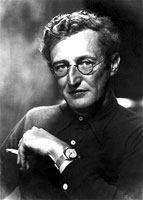
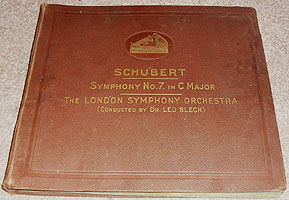 that he was ousted and forced to emigrate only in 1937 attests to his esteemed status despite his "degenerate" religion – and recorded with its orchestra mostly overtures and short pieces that impress with their alacrity and vibrancy. This very first recording of the "Great" belies his reputation for clarity and elegance and hardly gave first-time listeners an impartial perspective of an unfamiliar work. It's tempting to assume that Blech felt compelled to rebut and disprove the commonplace presumption that the "Great" was overly prolonged and boring, and so he over-compensated with wildly exaggerated tempos. Yet his few recordings of other symphonies, including the Haydn # 88 (Polydor, 1934) and Mozart # 34 (Electrola, 1930) display similar pacing schemes, with very quick fast movements and very measured slow ones. In any event, the first few moments here announce his individualistic plan, albeit subtly – he portrays the implicit "echo" of the third and sixth measures literally by audibly reducing the volume of the horns. Overall, within the movements he adheres to a rather mechanical presentation of tempos – loud or climactic passages are fast while gentler, sustained portions are slow – a scheme that, while superficially engaging, becomes rather predictable. Thus, the introduction begins very deliberately, accelerates to meet the allegro, continues to quicken through the exposition to breakneck speed, relaxes somewhat for the more lyrical development and then plunges headlong into the coda (until the very end, which decelerates to a standstill, as though in congratulation for having arrived). Even so, in the sections of extreme speed a balance favoring heavy bass at the expense of barely audible winds has the effect of blurring many details and thus can sound rushed and even frantic. The Andante continually heaves jaggedly among tempo extremes, slowing for partial cadences even in mid-phrase and, in a highly melodramatic touch, rushes headlong to a shattering climax that obliterates the pace, with the recovery barely moving at all. In comparison, the scherzo and finale are relatively straight-forward, the latter thrillingly paced until slowing for a majestic ending. Yet Blech concludes with a sharp reminder of his artistic prerogative – rather than going along with either of the standard interpretations of Schubert's ambiguous final expressive marking, he not only plays the last chord short but as a rinforzando (suddenly getting louder).
that he was ousted and forced to emigrate only in 1937 attests to his esteemed status despite his "degenerate" religion – and recorded with its orchestra mostly overtures and short pieces that impress with their alacrity and vibrancy. This very first recording of the "Great" belies his reputation for clarity and elegance and hardly gave first-time listeners an impartial perspective of an unfamiliar work. It's tempting to assume that Blech felt compelled to rebut and disprove the commonplace presumption that the "Great" was overly prolonged and boring, and so he over-compensated with wildly exaggerated tempos. Yet his few recordings of other symphonies, including the Haydn # 88 (Polydor, 1934) and Mozart # 34 (Electrola, 1930) display similar pacing schemes, with very quick fast movements and very measured slow ones. In any event, the first few moments here announce his individualistic plan, albeit subtly – he portrays the implicit "echo" of the third and sixth measures literally by audibly reducing the volume of the horns. Overall, within the movements he adheres to a rather mechanical presentation of tempos – loud or climactic passages are fast while gentler, sustained portions are slow – a scheme that, while superficially engaging, becomes rather predictable. Thus, the introduction begins very deliberately, accelerates to meet the allegro, continues to quicken through the exposition to breakneck speed, relaxes somewhat for the more lyrical development and then plunges headlong into the coda (until the very end, which decelerates to a standstill, as though in congratulation for having arrived). Even so, in the sections of extreme speed a balance favoring heavy bass at the expense of barely audible winds has the effect of blurring many details and thus can sound rushed and even frantic. The Andante continually heaves jaggedly among tempo extremes, slowing for partial cadences even in mid-phrase and, in a highly melodramatic touch, rushes headlong to a shattering climax that obliterates the pace, with the recovery barely moving at all. In comparison, the scherzo and finale are relatively straight-forward, the latter thrillingly paced until slowing for a majestic ending. Yet Blech concludes with a sharp reminder of his artistic prerogative – rather than going along with either of the standard interpretations of Schubert's ambiguous final expressive marking, he not only plays the last chord short but as a rinforzando (suddenly getting louder).
- Hamilton Harty, Hallé Orchestra (Columbia 78s, Pristine CD or download, 1928)
England also gave us our second "Great" (and the first truly complete one,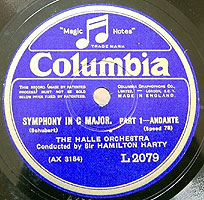
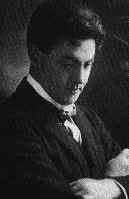 albeit without any repeats, as Blech had cut 118 bars from the da capo scherzo – a curious omission, as the complete movement still would have fit comfortably on two four-minute sides). If the Blech set was a deeply personal interpretation steeped in Romantic license, Harty's approaches the opposite pole of the spectrum, presenting the "Great" with a minimum of interpretive liberty. Yet it's far from rigid – just subtle, with gradual tempo adjustments that seem more in keeping with Schubert's artistic temperament. As a result, rather than challenging us with constant shifts, the few times that Harty does something radical really stand out, as when he grinds to a near-halt for the final moments of the first movement, suddenly accelerates the da capo scherzo and presents the end of the finale with an enormous sense of grandeur. (His sudden shift from the opening to the allegro seems an artifact of joining two 78 rpm sides together nowadays; at the time, it would have been far less evident after pausing for the necessary side change.) Throughout we are treated to a high degree of technical polish, attention to precise accents and careful differentiation between slurred and separated notes, abetted by recorded quality that presents the instrumental timbres and balances with extraordinary clarity for the time, all of which further testify to the extraordinary level of excellence of the Hallé Orchestra, which Harty had developed and led since 1920. Perhaps the most remarkable movement is the second, which seems to breathe with organic unity while fascinating with the constant interplay of the accompanying figures. Harty recorded quite prolifically, through a broad swath of the classical and romantic repertoire, and also led the Hallé in a pioneering 1927-8 set of Schubert's incidental music to Rosamunde, of which only the popular overture and a few other excerpts had previously been recorded.
albeit without any repeats, as Blech had cut 118 bars from the da capo scherzo – a curious omission, as the complete movement still would have fit comfortably on two four-minute sides). If the Blech set was a deeply personal interpretation steeped in Romantic license, Harty's approaches the opposite pole of the spectrum, presenting the "Great" with a minimum of interpretive liberty. Yet it's far from rigid – just subtle, with gradual tempo adjustments that seem more in keeping with Schubert's artistic temperament. As a result, rather than challenging us with constant shifts, the few times that Harty does something radical really stand out, as when he grinds to a near-halt for the final moments of the first movement, suddenly accelerates the da capo scherzo and presents the end of the finale with an enormous sense of grandeur. (His sudden shift from the opening to the allegro seems an artifact of joining two 78 rpm sides together nowadays; at the time, it would have been far less evident after pausing for the necessary side change.) Throughout we are treated to a high degree of technical polish, attention to precise accents and careful differentiation between slurred and separated notes, abetted by recorded quality that presents the instrumental timbres and balances with extraordinary clarity for the time, all of which further testify to the extraordinary level of excellence of the Hallé Orchestra, which Harty had developed and led since 1920. Perhaps the most remarkable movement is the second, which seems to breathe with organic unity while fascinating with the constant interplay of the accompanying figures. Harty recorded quite prolifically, through a broad swath of the classical and romantic repertoire, and also led the Hallé in a pioneering 1927-8 set of Schubert's incidental music to Rosamunde, of which only the popular overture and a few other excerpts had previously been recorded.
- Adrian Boult, BBC Symphony (HMV 78s, Beulah CD, 1934)
The third recorded ”Great” hailed yet again from England. 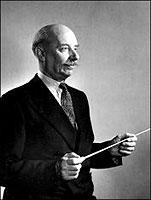
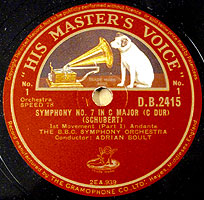 Adrian Boult had established the BBC Symphony Orchestra in 1930, served as its principal conductor for the next two decades (until forced to retire at the ridiculously young age of 60) and developed it into one of the finest British orchestras of the time. Known as a close associate of the major English composers of his time, his fame rested largely as an unabashed advocate of their music both in concert and on records. As noted by Edward Rothstein in a New York Times obituary, he occasionally was criticized as rather dull in other repertoire, fundamentally due to his approach marked by taste and precision, shaped by crisp restraint. Peter Hughes, in the Gramophone, agreed that Boult’s desire to convey the composer’s wishes “sometimes led him to conduct in a way that others perceived as perfunctory and passionless.” Here Boult presents a bracing reading that boasts superb balances among the instrumental lines (except in the finale, in which the detailed accompaniment, and especially the repeated violin figures, tend to get submerged in the overall sonic blend), abetted by an exceptionally clear recording. Tempo adjustments are generally subtle, with acceleration for transitions and slight slowing for lyrical portions, endings and the entire trio. Forte and piano sections are strongly differentiated; perhaps too much so, as little is left in reserve for the portions marked ff or fff. The playing is enthusiastic throughout, with particularly emphatic sforzandos, flagging only toward the end of the finale, not unexpected in the “real time” recording process. Only the first scherzo repeat is included. Given the overall objectivity of Boult’s approach, one wonders if HMV sought to replace its quirky Blech album with one apt to be viewed as more competitive with the Harty set issued by its rival Columbia. Boult would go on to record the “Great” twice more – for Nixa in 1955 with the London Philharmonic (identified in the American Westminster LP release as the “Philharmonic Promenade Orchestra” for contractual reasons) and again with the London Philharmonic for EMI in 1972. (A 1969 BBC Symphony concert rendition was released on a BBC Legends CD as well, with timings nearly identical to the 1972 studio version.) The remakes are more smoothly sculpted, preserving much of the careful balances of the original while lacking its intense dynamics, phrasing and overall energy. Each movement is paced about a minute slower, and all repeats are taken in the scherzo and trio.
Adrian Boult had established the BBC Symphony Orchestra in 1930, served as its principal conductor for the next two decades (until forced to retire at the ridiculously young age of 60) and developed it into one of the finest British orchestras of the time. Known as a close associate of the major English composers of his time, his fame rested largely as an unabashed advocate of their music both in concert and on records. As noted by Edward Rothstein in a New York Times obituary, he occasionally was criticized as rather dull in other repertoire, fundamentally due to his approach marked by taste and precision, shaped by crisp restraint. Peter Hughes, in the Gramophone, agreed that Boult’s desire to convey the composer’s wishes “sometimes led him to conduct in a way that others perceived as perfunctory and passionless.” Here Boult presents a bracing reading that boasts superb balances among the instrumental lines (except in the finale, in which the detailed accompaniment, and especially the repeated violin figures, tend to get submerged in the overall sonic blend), abetted by an exceptionally clear recording. Tempo adjustments are generally subtle, with acceleration for transitions and slight slowing for lyrical portions, endings and the entire trio. Forte and piano sections are strongly differentiated; perhaps too much so, as little is left in reserve for the portions marked ff or fff. The playing is enthusiastic throughout, with particularly emphatic sforzandos, flagging only toward the end of the finale, not unexpected in the “real time” recording process. Only the first scherzo repeat is included. Given the overall objectivity of Boult’s approach, one wonders if HMV sought to replace its quirky Blech album with one apt to be viewed as more competitive with the Harty set issued by its rival Columbia. Boult would go on to record the “Great” twice more – for Nixa in 1955 with the London Philharmonic (identified in the American Westminster LP release as the “Philharmonic Promenade Orchestra” for contractual reasons) and again with the London Philharmonic for EMI in 1972. (A 1969 BBC Symphony concert rendition was released on a BBC Legends CD as well, with timings nearly identical to the 1972 studio version.) The remakes are more smoothly sculpted, preserving much of the careful balances of the original while lacking its intense dynamics, phrasing and overall energy. Each movement is paced about a minute slower, and all repeats are taken in the scherzo and trio.
- Frederick Stock, Chicago Symphony (Columbia 78s, Lys CD, 1940)
Of the next "Greats" to appear,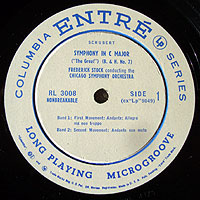
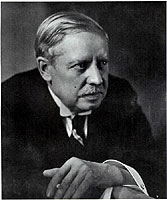 Bruno Walter and the London Symphony Orchestra (HMV, 1938) and Arturo Toscanini and the Philadelphia Orchestra (RCA Victor, 1941), both detailed below, afford a special fascination in the context of their conductors' evolving styles. Stock and the Chicago Symphony, though, provide the first recording to emanate from outside England. Stock spent his entire career at the Chicago Symphony and served as its leader for 37 years, a remarkable tenure exceeded only by Mengelberg's half-century at Amsterdam and Ormandy's 44 years at Philadelphia. Stock was reputed for his modesty, dignity and direct approach (and consequently is often overlooked nowadays when compared to his more overtly dynamic contemporaries). Yet his recordings of short pieces tend to belie that disposition, as many tend to be quite animated, and occasionally even overwrought. His recordings of major works, though, elude a consistent style and reflect considerable adaptability – reliable accompaniment (rather placid for Schnabel in 1942 Beethoven Fourth and Fifth Piano Concertos and fiery for Milstein in a 1940 Tchaikovsky Violin Concerto), lots of sudden gear-shifting in a 1927 Tchaikovsky Fifth, a fairly detached 1940 Strauss Also Sprach Zarathustra, and Schumann First (1929) and Fourth (1941) Symphonies that lie comfortably in between. Here, bold dynamics, punchy accents and plenty of finely-judged tempo variation all contribute to a swift, emphatic and vivid first movement in which interest never threatens to lapse. The Andante is paced as more of a trot than a walk, with each section differentiated by an emotionally-appropriate tempo. The scherzo bounds with irrepressible energy, yet ideally balanced against terpsichorean grace. My only quibble is with the anomalous finale, in which broad tempo shifts tend to mar a sense of tireless momentum. Even so, the entire performance sounds fully engaged yet wholly natural.
Bruno Walter and the London Symphony Orchestra (HMV, 1938) and Arturo Toscanini and the Philadelphia Orchestra (RCA Victor, 1941), both detailed below, afford a special fascination in the context of their conductors' evolving styles. Stock and the Chicago Symphony, though, provide the first recording to emanate from outside England. Stock spent his entire career at the Chicago Symphony and served as its leader for 37 years, a remarkable tenure exceeded only by Mengelberg's half-century at Amsterdam and Ormandy's 44 years at Philadelphia. Stock was reputed for his modesty, dignity and direct approach (and consequently is often overlooked nowadays when compared to his more overtly dynamic contemporaries). Yet his recordings of short pieces tend to belie that disposition, as many tend to be quite animated, and occasionally even overwrought. His recordings of major works, though, elude a consistent style and reflect considerable adaptability – reliable accompaniment (rather placid for Schnabel in 1942 Beethoven Fourth and Fifth Piano Concertos and fiery for Milstein in a 1940 Tchaikovsky Violin Concerto), lots of sudden gear-shifting in a 1927 Tchaikovsky Fifth, a fairly detached 1940 Strauss Also Sprach Zarathustra, and Schumann First (1929) and Fourth (1941) Symphonies that lie comfortably in between. Here, bold dynamics, punchy accents and plenty of finely-judged tempo variation all contribute to a swift, emphatic and vivid first movement in which interest never threatens to lapse. The Andante is paced as more of a trot than a walk, with each section differentiated by an emotionally-appropriate tempo. The scherzo bounds with irrepressible energy, yet ideally balanced against terpsichorean grace. My only quibble is with the anomalous finale, in which broad tempo shifts tend to mar a sense of tireless momentum. Even so, the entire performance sounds fully engaged yet wholly natural.
- Charles Mackerras, Orchestra of the Age of Enlightenment (Virgin, 1987)
- Roger Norrington, The London Classical Players (EMI, 1988)
- Roy Goodman, The Hanover Band (Nimbus, 1989)
- Franz Bruggen, Orchestra of the 18th Century (Philips, 1997)
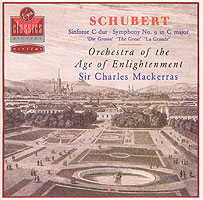 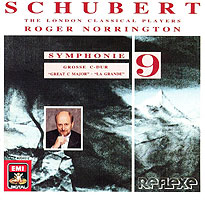
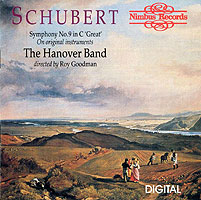
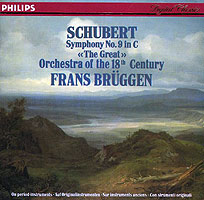 |
Having encountered some stylistic extremes, a useful perspective is provided by historically-informed renditions that not only observe all the repeats but use period instruments played at a lower pitch with techniques of the time in ensembles of a size typical of Schubert's era – that is, they attempt to replicate a performance that Schubert himself would have heard. The first to emerge was by the Orchestra of the Age of Enlightenment – 40 strings (11-8-8-8-5), pairs of flutes, clarinets and bassoons, 4 horns, 3 trumpets, 3 trombones and timpani, all played on actual instruments in use at the time (or, in a few instances, modern copies) – soon joined by the London Classical Players and the Hanover Band, and eventually by the Orchestra of the 18th Century. Even within the stylistic bounds prescribed by careful research, the four versions display some significant and interesting differences, especially with respect to tempos. Thus in the first movement Mackerras and Goodman are rather strict within a basic pulse, whereas Bruggen opts for a slow introduction and a wild coda, while Norrington begins much faster so as to create a unique sense of urgent expectation before becoming flexible throughout the remainder. Textures, too, vary considerably – although rather soft overall, Mackerras's brass dominate his strings, Norrington varies the dynamics to mold phrases, Goodman's dynamics are even stronger, but mellowed by a more reverberant hall (actually a church), and Bruggen displays more prominent timpani and colors his Andante with romanticized tempo variations. All benefit (or, from an impatient modern vantage, suffer) from including all the repeats to produce hour-long events – and Norrington goes even further by taking inner repeats not only within both halves of the first scherzo statement but within its da capo reappearance as well, thus adding another two minutes to his third movement.
Far from a gimmick, the period performance approach invokes the esthetic expectations that the composer undoubtedly had in mind when crafting his work and that clearly framed and colored his creative concept. A debate that remains unresolved (and largely a matter of personal taste) is whether this provides a valid esthetic corrective for modern listeners, or whether it self-consciously ignores the augmented resources to which we have become accustomed and which we have come to accept as intensifying older music.
- Willem Mengelberg, Concertgebouw Orchestra of Amsterdam (live 1940, Andromeda CD; studio 1943, Philips LP, Biddulph CD)
These two roughly contemporaneous Mengelberg recordings
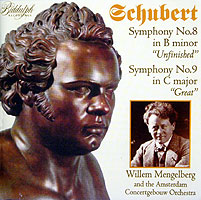 sound radically different and provide a further perspective as extreme examples of the disparity that can arise between concert and studio results. Even aside from its rougher sonics and more prominent timpani, the concert version has not only greater speed, sharper accents and more pronounced dynamics but a focused, driven intensity that the studio recording smoothes out. Yet the fundamental approach and many specific gestures are similar – an introduction filled with near-constant rubato leading to an allegro of exquisitely smooth transitions among bold tempos, colored throughout with intense lyricism and variegated color; an Andante that at first careens amid isolated sections as if to display their possibilities and then integrates them toward a heated climax that subsides amid flecks of dispelled energy; and a scherzo that slyly teases with agogic phrasing and a trio of lilting lyricism and elegance. True to his reputation, "Mangelberg" couldn't resist "helping" the composer by altering the score, here having the strings play pizzicato during the entire trio. Yet unlike some of his notorious "improvements," this effect sounds quite tasteful and advances the lyrical essence. Unusually for the time, the initial repeats of both the scherzo and trio are observed (and in the studio the da capo repeat as well).
sound radically different and provide a further perspective as extreme examples of the disparity that can arise between concert and studio results. Even aside from its rougher sonics and more prominent timpani, the concert version has not only greater speed, sharper accents and more pronounced dynamics but a focused, driven intensity that the studio recording smoothes out. Yet the fundamental approach and many specific gestures are similar – an introduction filled with near-constant rubato leading to an allegro of exquisitely smooth transitions among bold tempos, colored throughout with intense lyricism and variegated color; an Andante that at first careens amid isolated sections as if to display their possibilities and then integrates them toward a heated climax that subsides amid flecks of dispelled energy; and a scherzo that slyly teases with agogic phrasing and a trio of lilting lyricism and elegance. True to his reputation, "Mangelberg" couldn't resist "helping" the composer by altering the score, here having the strings play pizzicato during the entire trio. Yet unlike some of his notorious "improvements," this effect sounds quite tasteful and advances the lyrical essence. Unusually for the time, the initial repeats of both the scherzo and trio are observed (and in the studio the da capo repeat as well).
![]() Three "Golden Age" conductors (plus one from the succeeding generation) have left us multiple readings of the "Great" that provide a fascinating opportunity to trace their changing approaches as their careers progressed.
Three "Golden Age" conductors (plus one from the succeeding generation) have left us multiple readings of the "Great" that provide a fascinating opportunity to trace their changing approaches as their careers progressed.
- Bruno Walter – London Symphony (1938, HMV 78s, Pristine CD or download); NBC Symphony (1940 broadcast concert, private sources); Philharmonic Symphony of New York (1946, Columbia LP, Lys CD); Columbia Symphony (1959, Columbia LP, Sony CD)
Of all the great conductors,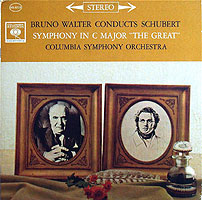
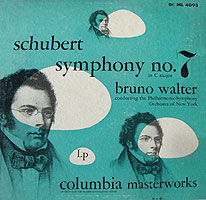 Bruno Walter was the most closely identified with Vienna, and so it's a shame that he never got to record the echt-Viennese "Great" with the premier Viennese orchestra – his 1936 HMV Vienna Philharmonic "Unfinished" is one of total commitment and immersion – but the Anschluss intervened. Walter may have meant to transfer much of his warm, rich and vibrant Viennese spirit to the London Philharmonic later that year, but except for a rustic scherzo the result is rather perfunctory and devoid of charm, further hampered by shaky ensemble. Shortly after settling in the US he led an NBC broadcast that boasts focus, character, a remarkable blend of virility and beauty, strongly differentiated but smoothly integrated tempos, felicitous details and striking precision (but after all, he was guest-conducting Toscanini's orchestra). Alas, while it's the richest Walter recording of the "Great" it's also the hardest to find. His 1946 New York studio take is fundamentally similar, albeit slightly more diffuse, and still gives a good impression of balancing the personalities of the Old World and his adopted home. His stereo recording with the Columbia Symphony (comprised mostly of Los Angeles Philharmonic members) reflects the final transformation of Walter's career, this time not due to political and social dislocation but rather the result of age and a heart attack, which buffed his earlier cutting edge into a mellow search for pure beauty. The scherzo is hugely effective and affecting – an ideal blend of controlled power, subtle inflection and inherent grace that radiates an aura of inner peace, bracketing a trio of infinite tenderness. The rest is somewhat bland – steady, slower and a bit hesitant and tired – yet unfortunately it's the only Walter recording of the "Great" that's generally available and which most listeners are apt to know.
Bruno Walter was the most closely identified with Vienna, and so it's a shame that he never got to record the echt-Viennese "Great" with the premier Viennese orchestra – his 1936 HMV Vienna Philharmonic "Unfinished" is one of total commitment and immersion – but the Anschluss intervened. Walter may have meant to transfer much of his warm, rich and vibrant Viennese spirit to the London Philharmonic later that year, but except for a rustic scherzo the result is rather perfunctory and devoid of charm, further hampered by shaky ensemble. Shortly after settling in the US he led an NBC broadcast that boasts focus, character, a remarkable blend of virility and beauty, strongly differentiated but smoothly integrated tempos, felicitous details and striking precision (but after all, he was guest-conducting Toscanini's orchestra). Alas, while it's the richest Walter recording of the "Great" it's also the hardest to find. His 1946 New York studio take is fundamentally similar, albeit slightly more diffuse, and still gives a good impression of balancing the personalities of the Old World and his adopted home. His stereo recording with the Columbia Symphony (comprised mostly of Los Angeles Philharmonic members) reflects the final transformation of Walter's career, this time not due to political and social dislocation but rather the result of age and a heart attack, which buffed his earlier cutting edge into a mellow search for pure beauty. The scherzo is hugely effective and affecting – an ideal blend of controlled power, subtle inflection and inherent grace that radiates an aura of inner peace, bracketing a trio of infinite tenderness. The rest is somewhat bland – steady, slower and a bit hesitant and tired – yet unfortunately it's the only Walter recording of the "Great" that's generally available and which most listeners are apt to know.
- Wilhelm Furtwängler – Berlin Philharmonic (December 8, 1942 Berlin concert, DG CD); Vienna Philharmonic (May 12, 1943 Stockholm concert, Music and Arts CD); Berlin Philharmonic (1951, DG LP and CD); Vienna Philharmonic (August 30, 1953 Salzburg concert, Virtuoso CD); Berlin Philharmonic (September 15, 1953 Berlin concert, Music and Arts CD)
Our documented transformation of Furtwängler's "Greats" derives from the last decade of his life. While extreme enough, it was preceded by an earlier and even more radical change when he was wrenched from being an exemplar of solid German tradition into the torment of a sensitive artist forced into the appalling abyss of the Third Reich. 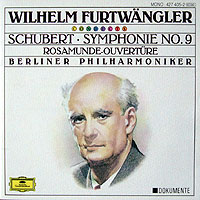
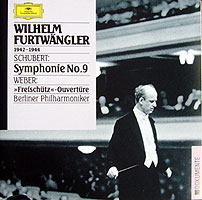 As in all his wartime concerts, Furtwängler transmuted music into a deeply personal reflection of his agony, hewing intense imagery of visceral impact. The 1942 Berlin introduction is harsh, with menacing horns warning of a coming storm and winds cowering in fear. The allegro is filled with painful outbursts fueled by furious timpani, its deliberately unconvincing islands of relative calm cruelly offering only fleeting relief, and its extreme tempos representing a universe bounded by pain and delusion, culminating in a violently fast and brutal coda that spins out of control before grinding to an exhausted halt. The Andante is grindingly slow, drenched throughout in loss and mourning, with harsh textures and severe collisions between soft passages and loud outbursts, its energy forced and desperate, denying any sense of true respite. The main climax is followed by nearly ten seconds of shocked silence before life struggles to emerge once more, its sloth admitting only the barest of hope. The scherzo is comparatively conventional, but remains dark-hued and somber, while the blaring brass and thundering timpani of the finale recall the elemental struggle of the first movement, as the vicissitudes of tempo invoke the pressures of life crushed by war before plunging into a delirious coda that crumbles into anarchy to deny any hope of final redemption.
As in all his wartime concerts, Furtwängler transmuted music into a deeply personal reflection of his agony, hewing intense imagery of visceral impact. The 1942 Berlin introduction is harsh, with menacing horns warning of a coming storm and winds cowering in fear. The allegro is filled with painful outbursts fueled by furious timpani, its deliberately unconvincing islands of relative calm cruelly offering only fleeting relief, and its extreme tempos representing a universe bounded by pain and delusion, culminating in a violently fast and brutal coda that spins out of control before grinding to an exhausted halt. The Andante is grindingly slow, drenched throughout in loss and mourning, with harsh textures and severe collisions between soft passages and loud outbursts, its energy forced and desperate, denying any sense of true respite. The main climax is followed by nearly ten seconds of shocked silence before life struggles to emerge once more, its sloth admitting only the barest of hope. The scherzo is comparatively conventional, but remains dark-hued and somber, while the blaring brass and thundering timpani of the finale recall the elemental struggle of the first movement, as the vicissitudes of tempo invoke the pressures of life crushed by war before plunging into a delirious coda that crumbles into anarchy to deny any hope of final redemption.
Clearly this astounding transformation was a product of its time and place – our next Furtwängler "Great," although only five months later, arose in Sweden, a neutral country where he briefly breathed freer air and associated with emissaries from the free world. While the movement timings are virtually identical, the aggressive edge has disappeared, its textures smoothed out and its power tempered by sweetness. The Andante admits some peaceful repose and the finale a degree of triumph. While still a potent statement, bold and expressive in its own right, it seems comparatively abstract and largely shorn of extra-musical associations.
Although often lauded as among Furtwängler's finest achievements, his only studio "Great" pales beside his concert readings, of which its fans perhaps are unaware. Indeed, Furtwängler is rarely at his most compelling in the sterile confines of the studio, which he disdained and where he often steered a safe course. Here, emotional extremes are modulated and smoothly blended, and the prior sense of struggle and conflict is subsumed by monumental architecture. The thin fidelity adds to an impression of shallowness compared to the concerts. Yet, a further factor was operative – after the War Furtwängler found an inner peace and spirituality that added a new sense of depth, intensity and commitment to his work, all of which are abundantly evident in his 1953 Berlin concert in which power and energy are redirected constructively and positively, culminating in a finale coda of ecstatic triumph. Even so, his demons were not entirely gone – his hearing had begun to deteriorate and protests over his presumed but largely mistaken identification with the Nazis led to European protests and an effective bar from America. His 1953 Salzburg concert points out another factor – he poured himself without reserve into the Berlin Philharmonic, which he had led since 1922 and with which he developed a telepathic empathy that enabled them to decipher his enigmatic podium gestures into extraordinary sound, an ability that no other orchestra developed to a similar degree. The Vienna Philharmonic was his second home and came the closest but rarely produced the same degree of cohesive profundity as the Berliners. The Salzburg rendition preserved here, given within two weeks of the Berlin concert, is a fine example of Furtwängler's late style but falls short of the last degree of commitment displayed in Berlin.
- Arturo Toscanini – New York Philharmonic (April 26, 1936 concert); NBC Symphony (January 1, 1938 concert); Philadelphia (1941, RCA LP and CD); NBC Symphony (1947, RCA LP and CD); La Scala (September 16, 1948 concert); NBC Symphony (February 7, 1953 concert); NBC Symphony (1953, RCA LP and CD)
As with Walter, Toscanini's current reputation is based largely upon his studio recordings toward the very end of his life rather than the far different, and often far more interesting, concerts and recordings from earlier phases. 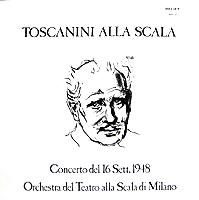
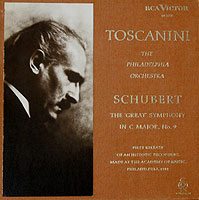 Even though they all come from the final third of his career, the extant versions of his "Greats" tend to confirm the conventional wisdom that his style became simplified as he aged. Remarkably, Toscanini included the "Great" in his very first orchestral concert in Turin on March 20, 1896 but then dropped it from his repertoire for over three decades, after which it became one of his favorite works. (Incidentally, while the program for that debut might seem to validate criticism that his taste was conservative, we should note that all the works were local premieres and quite "modern" at the time – the Brahms Tragic Overture, receiving its first performance in Italy, was 16 years old and the Tchaikovsky Nutcracker Suite a mere five.)
Even though they all come from the final third of his career, the extant versions of his "Greats" tend to confirm the conventional wisdom that his style became simplified as he aged. Remarkably, Toscanini included the "Great" in his very first orchestral concert in Turin on March 20, 1896 but then dropped it from his repertoire for over three decades, after which it became one of his favorite works. (Incidentally, while the program for that debut might seem to validate criticism that his taste was conservative, we should note that all the works were local premieres and quite "modern" at the time – the Brahms Tragic Overture, receiving its first performance in Italy, was 16 years old and the Tchaikovsky Nutcracker Suite a mere five.)
Our first Toscanini studio "Great" was the first work he recorded in Philadelphia after he briefly swapped podiums with Stokowski, and the result has aptly been hailed as altogether extraordinary, although not at the time – the masters were damaged during processing (wartime shortages were blamed) and resurrected only in 1961 when, in preparation for a memorial broadcast, engineer John Corbett reportedly spent 750 hours meticulously hand-splicing the tics from a tape transfer of the glass-based acetates. Released in RCA's deluxe Soria LP series to enormous critical acclaim, the result echoed Henry Pleasants' review of the concert: "The long Schubert symphony was kept alive by a rhythmic exactness and continuity that allowed no dead spots and it was made eloquent by countless felicitous details of inflection and a superlative sense of form." Heard today, the combination of Toscanini's concentration and the sheer lush beauty of the orchestra's trademark sound remain stunning. While each section adheres to a basic steady tempo, albeit with subtle plasticity, the compelling sonority subtly immerses us while obviating any need for overt drama. Yet much detail is lost, possibly stripped out of the original through aggressive processing, or perhaps a result of the engineers' being accustomed to Stokowski's highlighting of key lines which Toscanini declined to manipulate.
While the Philadelphia version lay dormant, Toscanini cut his then-first studio recording of the "Great" in 1947. By then he had molded the NBC Symphony into an ideal instrument to convey his late style but the fidelity is atypically flat and draws attention to brittle phrasing and an overall dearth of warmth or lyricism. Perhaps recognizing both its technical and esthetic flaws, Toscanini and the NBC rerecorded the "Great" in 1953 in a far more representative exemplar of his late ideal, proceeding with near rock-steady tempos, crisp playing, barely-shaped phrases, and timpani that break through the texture at climaxes, with little to detract from the abstract musical content, neither perfunctory nor monumental nor tender. As with all his renditions, the Andante is taken at a far quicker pace than nearly any others (about 12½ minutes vs. a common 15 or so), turning the walk into a trot and lending an impression of inevitability and restlessness that guards against any sense of indolence or needless replication.
Toscanini's three studio "Greats" are supplemented with several recorded concerts. 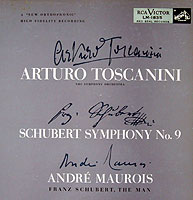
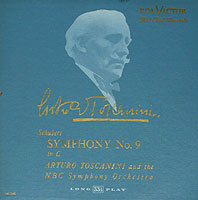 Our first (alas, available only from private sources) comes from his 1936 penultimate concert with the New York Philharmonic, which he had led for seven seasons. Despite dim fidelity (barely of short-wave quality) we can perceive smoothly blended sound, softened climaxes, convincing lyrical episodes and, after a steady introduction, ample subtle tempo fluctuation, all reminiscent of his earlier flexible style. Our next document (also only privately available) is his 1938 second concert with his then-new NBC Symphony and is strikingly similar but with notably sharper dynamic contrasts. A 1948 concert with the La Scala Orchestra, which he led in all but two of his post-war European concerts, hastens the inner movements (each over a half-minute quicker than even his own rapid norm). While it is flavored throughout by flexible tempos compared to the 1947 NBC recording, the scherzo bounds ahead with special energy and a one-to-a-bar feeling of relentless determination. (Note that its transfer on a Relief LP is a half-tone sharp, which produces a false sense of seeming to be hard-driven.) A February 7, 1953 NBC concert (Arkadia CD), given two days before his final studio recording, manages to temper the sharp edges of the "official" release with enough expressive touches to yield a potent reading that sounds thoroughly convincing.
Our first (alas, available only from private sources) comes from his 1936 penultimate concert with the New York Philharmonic, which he had led for seven seasons. Despite dim fidelity (barely of short-wave quality) we can perceive smoothly blended sound, softened climaxes, convincing lyrical episodes and, after a steady introduction, ample subtle tempo fluctuation, all reminiscent of his earlier flexible style. Our next document (also only privately available) is his 1938 second concert with his then-new NBC Symphony and is strikingly similar but with notably sharper dynamic contrasts. A 1948 concert with the La Scala Orchestra, which he led in all but two of his post-war European concerts, hastens the inner movements (each over a half-minute quicker than even his own rapid norm). While it is flavored throughout by flexible tempos compared to the 1947 NBC recording, the scherzo bounds ahead with special energy and a one-to-a-bar feeling of relentless determination. (Note that its transfer on a Relief LP is a half-tone sharp, which produces a false sense of seeming to be hard-driven.) A February 7, 1953 NBC concert (Arkadia CD), given two days before his final studio recording, manages to temper the sharp edges of the "official" release with enough expressive touches to yield a potent reading that sounds thoroughly convincing.
The evolution of Toscanini's "Greats" cannot be heard as a function of their overall timings, which show no consistent pattern, neither according to their chronology nor as a function of their studio vs. concert settings (1936 NYP concert = 45:50; 1938 NBC concert = 45:15; 1940 Philadelphia recording = 45:38; 1947 NBC recording = 44:52; 1948 La Scala concert = 44:40; 1953 NBC concert = 44:20; 1953 NBC recording = 45:47). Rather, they exhibit a general increase in detachment and a concurrent lessening of personalized interpretive input, as if to stand back and respect the composer to let the music have its own say – a harbinger of the objectivity of the historically-informed movement that, for better or worse, has largely shaped our modern esthetic. That the smooth Philadelphia version sounds the slowest of all serves to demonstrate that Toscanini's reputed pace is more a function of his lean and meticulous NBC textures than actual speed, which is often miscredited as the root of his distinctive approach.
- Leonard Bernstein – Boston Symphony (1957 concert, Living Stage CD); New York Philharmonic (1967, Columbia LP, Sony CD); Concertgebouw Orchestra of Amsterdam (1987 concert, DG CD)
As the proud leader of a new American breed,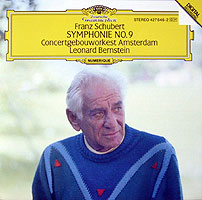
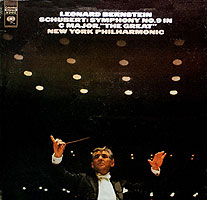 Bernstein stood proudly apart from the European "Golden Age" of conductors, yet his style evolved just as much over time. We are fortunate to have "Greats" from the close of each of the three primary phases of his career – his free-lance days in which he developed a reputation for headstrong visceral impact; his decade at the head of the New York Philharmonic in which he won over (most) doubters with overall excellence within a broad repertoire; and his DG concert recordings with a variety of orchestras in which he slowed tempos to the breaking point. Rather remarkably, though, his "Greats" tend to buck that general trend. His Boston concert is rather mainstream, distinguished mainly by an uncommonly fast (12:15) Andante paced even quicker (and rendered more emphatically) than most of Toscanini's. At the end of his Philharmonic tenure he thwarts expectations, emerging from the studio with a more highly-characterized reading of bolder and more differentiated tempos, although his Andante reverts to a far more conventional pace of over 15 minutes that loses the earlier urgency in favor of a tenuous balance between resolute determination and sweet warmth, as if to preserve energy for a far quicker and more vital finale. Twenty years later, as a grand old man of American music, his thick-textured Concertgebouw remake adheres closely to the Philharmonic model, but shorn of its spirited edge, its slower finale the only evidence of his career-closing deliberate pacing.
Bernstein stood proudly apart from the European "Golden Age" of conductors, yet his style evolved just as much over time. We are fortunate to have "Greats" from the close of each of the three primary phases of his career – his free-lance days in which he developed a reputation for headstrong visceral impact; his decade at the head of the New York Philharmonic in which he won over (most) doubters with overall excellence within a broad repertoire; and his DG concert recordings with a variety of orchestras in which he slowed tempos to the breaking point. Rather remarkably, though, his "Greats" tend to buck that general trend. His Boston concert is rather mainstream, distinguished mainly by an uncommonly fast (12:15) Andante paced even quicker (and rendered more emphatically) than most of Toscanini's. At the end of his Philharmonic tenure he thwarts expectations, emerging from the studio with a more highly-characterized reading of bolder and more differentiated tempos, although his Andante reverts to a far more conventional pace of over 15 minutes that loses the earlier urgency in favor of a tenuous balance between resolute determination and sweet warmth, as if to preserve energy for a far quicker and more vital finale. Twenty years later, as a grand old man of American music, his thick-textured Concertgebouw remake adheres closely to the Philharmonic model, but shorn of its spirited edge, its slower finale the only evidence of his career-closing deliberate pacing.
![]() From the hundred-plus other "Great" recordings (or at least among those I've heard),
From the hundred-plus other "Great" recordings (or at least among those I've heard),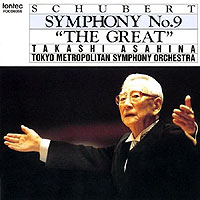
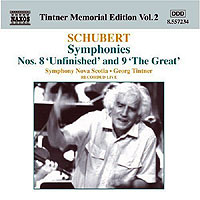 I've tried to select some that present a variety of interesting styles and perspectives. (So if I've omitted your own favorites – sorry!) First, though, in lieu of those boasting vaunted credentials (Bohm, Karajan, Solti, Wand, et al.), it seems fitting to note two recorded concerts that transcend the slight reputations of their conductors and ensembles. Georg Tintner and the Symphony Nova Scotia (1988, Naxos CD) provide a modest reading that seems to dwell well within the sound and feeling of the historically-informed discs noted above (yet with no repeats) and invoke the composer's own modest demeanor. A half-world away, both geographically and culturally, Takashi Asahina and the Tokyo Metropolitan Symphony Orchestra (1995, Fontec CD) or the Osaka Philharmonic (1998, Canyon CD) render remarkably accomplished, full-blooded "Greats" that project his idol Furtwängler's sense of architectural proportion with great dignity and power – middle-of-the-road, perhaps, but beautifully played and a notable achievement that documents the Japanese embrace of Western classics and, more generally, the world-wide appeal of Schubert's work.
I've tried to select some that present a variety of interesting styles and perspectives. (So if I've omitted your own favorites – sorry!) First, though, in lieu of those boasting vaunted credentials (Bohm, Karajan, Solti, Wand, et al.), it seems fitting to note two recorded concerts that transcend the slight reputations of their conductors and ensembles. Georg Tintner and the Symphony Nova Scotia (1988, Naxos CD) provide a modest reading that seems to dwell well within the sound and feeling of the historically-informed discs noted above (yet with no repeats) and invoke the composer's own modest demeanor. A half-world away, both geographically and culturally, Takashi Asahina and the Tokyo Metropolitan Symphony Orchestra (1995, Fontec CD) or the Osaka Philharmonic (1998, Canyon CD) render remarkably accomplished, full-blooded "Greats" that project his idol Furtwängler's sense of architectural proportion with great dignity and power – middle-of-the-road, perhaps, but beautifully played and a notable achievement that documents the Japanese embrace of Western classics and, more generally, the world-wide appeal of Schubert's work.
- Hermann Abendroth – Leipzig Radio Symphony Orchestra (1949, Arlecchino CD); Berlin Radio Orchestra (1955 concert, Tahra CD)
Often overlooked in the huge shadow cast by his compatriot Furtwängler, Abendroth's comparably impulsive and deeply personal interpretations cast a fascinating light on familiar works and challenge conventional perceptions with their vivid individuality. 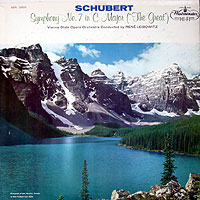
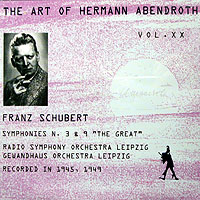 Of our two extant Abendroth "Greats" the Leipzig was recorded as a continuous performance for radio broadcast but is trumped by the later Berlin, a genuine concert with even bolder underlining (and a fully silent – and apparently utterly rapt – audience). Somewhat more fragmented than Furtwängler's broad structural vision, Abendroth's may not wear quite as well through repeated hearings but its appeal can be more immediately arousing in its compelling and surprising details – mammoth dynamic contrasts, a dizzying rush to the Andante climax, a nimbly probing aftermath, a finale that surges in tidal-waves of overwhelming energy. Most astonishing of all is an astoundingly assertive scherzo, steadfast in most hands but here charged with hair-raising vitality, followed by a soothingly tranquil trio propelled by a swaying pulse. Yet Abendroth never lapses into crudeness or a self-serving display of ego, but rather conveys an engrossing impression of total immersion and commitment.
Of our two extant Abendroth "Greats" the Leipzig was recorded as a continuous performance for radio broadcast but is trumped by the later Berlin, a genuine concert with even bolder underlining (and a fully silent – and apparently utterly rapt – audience). Somewhat more fragmented than Furtwängler's broad structural vision, Abendroth's may not wear quite as well through repeated hearings but its appeal can be more immediately arousing in its compelling and surprising details – mammoth dynamic contrasts, a dizzying rush to the Andante climax, a nimbly probing aftermath, a finale that surges in tidal-waves of overwhelming energy. Most astonishing of all is an astoundingly assertive scherzo, steadfast in most hands but here charged with hair-raising vitality, followed by a soothingly tranquil trio propelled by a swaying pulse. Yet Abendroth never lapses into crudeness or a self-serving display of ego, but rather conveys an engrossing impression of total immersion and commitment.
- René Leibowitz – Vienna State Opera Orchestra (1960, Westminster LP); Royal Philharmonic Orchestra (1962, Readers Digest LP)
A student of Schoenberg and Webern, and a theoretician, composer and ardent advocate of 12-tone music, Leibowitz stripped any vestige of romanticism from his performances of the romantic repertoire. His set of the Beethoven symphonies was (and still is) highly acclaimed despite its less-than-prestigious distributor. (But before sneering at Reader's Digest, let's not forget that amid its dross were some wonderful sets of jazz reissues and classical albums by famous artists – and it was among the highest-selling labels of its time that put lots of (mostly light) classical music into lots of mid-brow homes.) Leibowitz's first movement is utterly intrepid – a teasingly patient introduction that collides into a breathlessly-paced allegro and a frenzied coda, by far the fastest overall timings I've encountered – a mere 11:50 (compared to Toscanini's 13½) – that must have startled the unsuspecting Reader's Digest crowd seeking some pleasant relaxation. The remaining movements are relatively conventional, steadily paced with crisp, angular playing that suggests neither humor nor gravity, with the Vienna finale notably slower than the RPO's. Yet their moderation barely dilutes the striking impact of the allegro that invokes the headstrong energy of a youthful romp, far removed from adulthood, much less the weight of looming mortality.
- Charles Munch, Boston Symphony Orchestra (1958, RCA LP, BMG CD)
Charles Munch was pegged as a specialist, and hailed as an expert, in French music,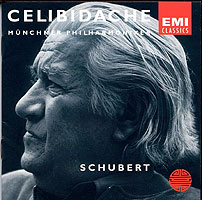
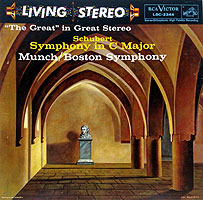 but often dismissed as slick and superficial in the German repertoire – rather surprising as he was born and raised in Alsace on the countries' borders and had one foot in both cultures. Admittedly, Koussevitzky was a tough act to follow when Munch took over the helm of the Boston Symphony in 1949, and yet he led magnificently vital readings of the German masters, including a sensationally propulsive and genuinely joyous 1958 Beethoven Ninth. His vibrant "Great" stands out among the crop of early stereo versions (genial Krips/London, stodgy Klemperer/Philharmonia) – excitingly paced but not over-driven, energetic but not overly aggressive, steadfast but with slightly moderated lyrical passages, delicate balances but without any excess charm, velocity tempered by full sonority, and recorded with thrillingly crisp fidelity (proclaimed on the original LP cover as: "'The Great' in Great Stereo"). The playing by the "Aristocrat of Orchestras" never lapses into the routine that its moniker might suggest and there are some startling details – a sublime shifting of textures in the trio and a subtle but brilliantly effective tweaking of the call and response passage toward the end of the Andante in which the trombones keep entering a smidge early to convey a sense of irrepressible urgency just as the energy threatens to flag. Neither quintessentially French nor German (and certainly not Viennese), perhaps Munch's "Great" is simply American, as is the clear-cut 1957 rendition by George Szell and the Cleveland Orchestra (Columbia LP, Sony CD).
but often dismissed as slick and superficial in the German repertoire – rather surprising as he was born and raised in Alsace on the countries' borders and had one foot in both cultures. Admittedly, Koussevitzky was a tough act to follow when Munch took over the helm of the Boston Symphony in 1949, and yet he led magnificently vital readings of the German masters, including a sensationally propulsive and genuinely joyous 1958 Beethoven Ninth. His vibrant "Great" stands out among the crop of early stereo versions (genial Krips/London, stodgy Klemperer/Philharmonia) – excitingly paced but not over-driven, energetic but not overly aggressive, steadfast but with slightly moderated lyrical passages, delicate balances but without any excess charm, velocity tempered by full sonority, and recorded with thrillingly crisp fidelity (proclaimed on the original LP cover as: "'The Great' in Great Stereo"). The playing by the "Aristocrat of Orchestras" never lapses into the routine that its moniker might suggest and there are some startling details – a sublime shifting of textures in the trio and a subtle but brilliantly effective tweaking of the call and response passage toward the end of the Andante in which the trombones keep entering a smidge early to convey a sense of irrepressible urgency just as the energy threatens to flag. Neither quintessentially French nor German (and certainly not Viennese), perhaps Munch's "Great" is simply American, as is the clear-cut 1957 rendition by George Szell and the Cleveland Orchestra (Columbia LP, Sony CD).
- Sergiu Celibidache, Munich Philharmonic (1994, EMI CD)
Celibidache often takes the somewhat dubious prize for the slowest performances on record, and so he does here, weighing in at 57 minutes with no repeats (not even in the first scherzo which nearly everyone takes). Although a far cry from the electrifying scurry of Leibowitz, it does generate its own power but in a far more massive way. Climaxes are monumental, majestic and controlled rather than sharp, stirring and impulsive, with conflict minimized and contrasts smoothed and buffered. The tempos are steady, the unfolding patient, the acoustic rich (but brightened by brilliant trumpets at emphatic moments). Beyond an overall feeling of stately gravity, the entire work seems fully integrated, with the scherzo and trio seamlessly melded and the outer movement codas natural culminations, reflecting strength through constancy and wisdom through authoritative discipline. It's hard to imagine that the young, pioneering Schubert conceived the "Great" in this way, yet it works, a compelling tribute to the universality of his genius.
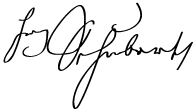 |
![]() I gratefully acknowledge the following sources for the quotations, references and factual information in this article. I'll take the blame for the opinions and judgments.
I gratefully acknowledge the following sources for the quotations, references and factual information in this article. I'll take the blame for the opinions and judgments.
- Berio, Luciano: author's note on the Luciano Berio Centro studi website (http://www.lucianoberio.org/node/1448?1304392085=1)
- Brockway, Wallace and Herbert Weinstock: Men of Music (Simon & Schuster, 1939)
- Brown, Maurice J. E.: "Franz Schubert" in Grove's Dictionary of Music and Musicians (St. Martin, 1954)
- Burton, Anthony: notes to the Sinopoli/Philharmonia LP (DG 410862, 1984)
- Carner, Mosco: "The Orchestral Music" in Gerald Abraham, ed., The Music of Schubert (Norton, 1947)
- Carse, Adam: History of Orchestration (Constable & Co., 1925)
- Cross, Milton: Encyclopedia of the Great Composers and Their Music (Doubleday, 1962)
- Cuyler, Louise: The Symphony (Harmonic Park Press, 1995)
- Downes, Edward: "Notes on the Music" in the Toscanini/Philadelphia Orchestra LP (RCA Soria LD 2663, 1962)
- Einstein, Alfred: A Short History of Music (Knopf, 1937)
- Frank, Mortimer: Arturo Toscanini – The NBC Years (Amadeus, 2002)
- Griffel, L. Michael: "Schubert's Orchestral Music" in Christopher Gibbs, ed.: The Cambridge Companion to Schubert (Cambridge University Press, 1997)
- Grove, George: "Franz Peter Schubert" in Grove's Dictionary of Music and Musicians (Theodore Presser, 1905)
- Hall, David: notes to the Toscanini/NBC Symphony LP (RCA LM 1040, 1950)
- Hughes, Spike: The Toscanini Legacy (Putnam, 1959)
- Johnson, David: notes to the Walter/Columbia Symphony LP (Columbia M2S 618, 1960)
- Kramer, Jonathan: Listen to the Music (Schirmer, 1988)
- Lang, Paul Henry: Music in Western Civilization (Norton, 1943)
- Maurois, Andre: "Franz Schubert – the Man" in the Toscanini/NBC Symphony LP (RCA LM 1835, 1954)
- Mann, William: notes to the Klemperer/Philharmonia LP (Angel S 35546, 1961)
- Mellers, Wilfred: Man and His Music, Volume III: The Sonata Principle (Schocken, 1969)
- Montgomery, David: "Franz Schubert's Music in Performace" in Christopher Gibbs, ed.: The Cambridge Companion to Schubert (Cambridge University Press, 1997)
- Norrington, Roger: notes to his London Classical Players LP (EMI CDC 749949 2, 1988)
- Northcott, Bayan: notes to the Mackerras/Orchestra of the Age of Enlightenment CD (Virgin VC 90708-2, 1988)
- Reed, John: Schubert (Oxford University Press, 1987)
- Reed, John: "Schubert's Reception History in 19th Century England" in Christopher Gibbs, ed.: The Cambridge Companion to Schubert (Cambridge University Press, 1997)
- Rosen, Charles: The Classical Style (Viking, 1971)
- Roy, Klaus G.: notes to the Szell/Cleveland LP (Angel S 36049, 1970)
- Schonberg, Harold: Lives of the Great Composers (Norton, 1981)
- Schumann, Robert [review of premiere] quoted in David Hall: notes to the Toscanini/NBC LP (RCA LM 1040, 1950)
- Shaw, Bernard: "Schubert's Symphony in C" in Louis Crompton, ed.: The Great Composers – Reviews and Bombardments (University of California, 1976)
- Sinopoli, Giuseppe: notes to his Philharmonia LP (DG 410 862, 1984)
- Spaeth, Sigmund: A Guide to Great Orchestral Music (Random House, 1943)
- Steinberg, Michael: The Symphony – A Listener's Guide (Oxford, 1995)
- Tovey, Donald Francis: Essays in Musical Analysis (Oxford, 1935)
- Truscott, Harold: "Franz Schubert" in Robert Simpson, ed.: The Symphony (Penguin, 1966)
- Winter, Robert: "Franz Schubert" in The New Grove Dictionary of Music and Musicians (MacMillan, 2001)
![]()
Copyright 2016 by Peter Gutmann
copyright © 1998–2016 by Peter Gutmann. All rights reserved.